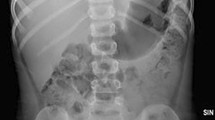Abstract
We report a case of perforation, fistula formation, and small bowel obstruction in a 2-year-old child who had ingested 32 small magnets. Multiple magnets will attract one another through the bowel wall and lead to pressure necrosis with complications. We recommend early surgical intervention before the onset of gastrointestinal complications if ingested multiple magnets have not moved on the follow-up radiograph. Both clinicians and the lay population need to be aware that multiple magnets can be hazardous foreign bodies for children.
Similar content being viewed by others
Avoid common mistakes on your manuscript.
Introduction
Small children often swallow small objects. Most ingested foreign bodies spontaneously pass through the gastrointestinal tract. However, when the foreign body is a magnet and more than one is ingested, they might attract one another through the bowel wall and cause pressure necrosis. We report a case with serious complications in a child who had ingested 32 small magnets.
Case report
A 2-year-old girl was transferred to our institute after a 4-day history of non-bilious vomiting. She was drowsy and had a fever of 38.0°C. On physical examination, her abdomen was slightly distended but without tenderness or guarding, and there were no audible bowel sounds. An abdominal radiograph showed distended loops of the small bowel and an opaque, long cylindrical structure that on closer observation was noted to be composed of 32 components (Fig. 1). The parents gave a history that the small pieces might be multiple magnets given to her by her grandmother. Emergent laparotomy was performed, and a jejunojejunal fistula causing small bowel obstruction was found. The fistula was 5 cm long but there was no foreign body in the fistula. There was a duodeno-jejunojejunal fistula that contained cylindrical magnets and the duodenum was perforated. The duodenal perforation was closed after debridement and the jejunal fistulas were repaired. The postoperative course was eventful; on postoperative day (POD) 3, infection appeared at the surgical site, and on POD 7, abdominal wall dehiscence occurred and relaparotomy was required. On POD 10, the patient developed pneumonia as a remote infection, but by POD 28 she had made a full recovery and was discharged from our institute.
Discussion
Small children often swallow foreign material, and if such an event goes unrecognized or is asymptomatic, a physician is not consulted. In 80–90% of cases, spontaneous passage through the gastrointestinal tract occurs after the foreign body has entered the small bowel [1].
In this case, we think the patient ingested these small magnets over a period of time and we are therefore unable to determine the amount of time necessary for fistula formation. The patient might have swallowed the magnets over a period of 1 month or more. Takao et al. [2] demonstrated that anastomosis between the common bile duct and the duodenum using magnets was established on day 32 after a procedure. Okajima et al. [3] reported that magnet compression reanastomosis for bile duct stenosis after duct-to-duct anastomosis was established on day 42 after the magnets were inserted.
The ingestion of only one magnet might not cause gastrointestinal complications because of its spontaneous passage through the digestive tract. However, multiple magnets can attract one another through the bowel wall, with ensuing pressure necrosis that can cause serious complications such as perforation, fistula formation, and small-bowel obstruction. In all previously reported cases, surgical intervention was necessary and the postoperative courses were not always uneventful [1, 4–8].
We recommend early surgical intervention before the onset of gastrointestinal complications if ingested multiple magnets have not moved on radiographic follow-up. Both clinicians and lay people need to be aware that multiple magnets can be especially hazardous foreign bodies for children. When a radiologist encounters multiple radiopaque foreign bodies in the abdomen, consultation with the referring physician is important to exclude the ingestion of magnets. If the foreign bodies are known or suspected to be magnets, an immediate surgical consultation should be obtained because of the potential for complications arising from the interaction among the magnets.
References
Schwartz GF, Polsky HS (1976) Ingested foreign bodies of the gastrointestinal tract. Am Surg 42:236–238
Takao S, Matsuo Y, Shinchi H, et al (2001) Magnetic compression anastomosis for benign obstruction of the common bile duct. Endoscopy 33:988–990
Okajima H, Kotera A, Takeichi T, et al (2005) Magnet compression anastomosis for bile duct stenosis after duct-to-duct biliary reconstruction in living donor liver transplantation. Liver Transpl 11:473–475
Cauchi JA, Shawis RN (2002) Multiple magnet ingestion and gastrointestinal morbidity. Arch Dis Child 87:539–540
Oestreich AE (2004) Multiple magnet ingestion alert. Radiology 233:615
Lee SK, Beck NS, Kim HH (1996) Mischievous magnets: unexpected health hazard in children. J Pediatr Surg 31:1694–1695
Honzumi M, Shigemori C, Ito H, et al (1995) An intestinal fistula in a 3-year-old child caused by the ingestion of magnets: report of a case. Surg Today 25:552–553
Kubota Y, Tokiwa K, Tanaka S, et al (1995) Intestinal obstruction in an infant due to magnet ingestion. Eur J Pediatr Surg 5:11
Author information
Authors and Affiliations
Corresponding author
Rights and permissions
About this article
Cite this article
Uchida, K., Otake, K., Iwata, T. et al. Ingestion of multiple magnets: hazardous foreign bodies for children. Pediatr Radiol 36, 263–264 (2006). https://doi.org/10.1007/s00247-005-0056-3
Received:
Revised:
Accepted:
Published:
Issue Date:
DOI: https://doi.org/10.1007/s00247-005-0056-3





